SWIR technology has long been used for a vast multitude of applications because of its distinct features.
Included in these are civil applications (solar cell inspection, bottling plant inspection, fruit inspection, fire fighting, etc.) and military applications (laser guiding systems, camouflage detection, surveillance, night vision, boarder monitoring, etc.).
The principle advantages of using SWIR technology in military applications is that SWIR cameras generally “see through” and image higher contrast images compared to visible through haze, mist, rain, fog and challenging atmospheric conditions. This paper demonstrates visibility to 35 KM through the thick haze of North Eastern Taiwan and explains the potential for seeing even further.
This is due to reduced Rayleigh scattering in the atmosphere at relatively longer wavelengths:
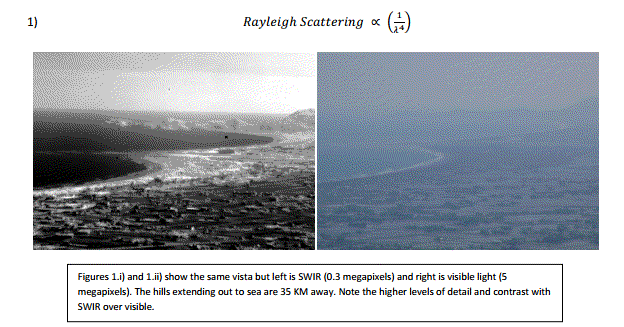
A simple way of thinking about this is imagining a sunset. As the sun lowers towards the horizon, less and less blue, green and yellow light permeate the atmosphere as they have shorter-than-red wavelengths. Red light, with a longer wavelength is not scattered so easily (and infrared light even less so), so the sun appears red. Therefore, as the concentration of particles of water vapour in the atmosphere increases, shorter wavelengths are scattered more than longer wavelengths are. This makes imaging in visible, UV and X-ray very difficult or impossible through bad weather.
Secondly SWIR can be used for night vision applications; however care must be taken to appreciate how to integrate these cameras with the right accessories to get the best impact. This is discussed further on in this article. Lastly, and most importantly from a military standpoint, SWIR is invisible to the human eye enabling covert operation. It is therefore a good choice for targeting with laser designators between 1060 nm and 1550 nm. These laser designators also have the advantage that they are eye-safe to very high powers.
Good surveillance operations rely on robust equipment that can handle any environmental conditions. This is why government and private services worldwide are turning to SWIR technology for naval, air and ground security.
SWIR for Counter-Aerial Surveillance
Modern fighter jets are equipped with the latest stealth technology making their presence virtually undetectable with even cutting edge RADAR surveillance systems. When they are at their fastest before attack, as they are travelling well beyond the speed of sound, the noise of a fighter’s engine will arrive only after the attack is completed.
It is for these reasons that optical technologies are being incorporated into more and more anti-air systems. As an air craft accelerates, the air temperature of the exhaust can exceed the minimum “visible” temperature with SWIR imaging.
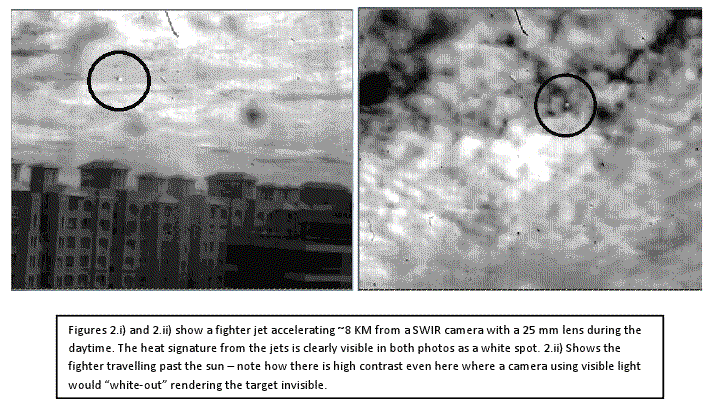
The exhaust jets appear as large white spots contrasted against the highly absorbing aircraft exterior. The visibility of this heat is only enhanced at night when the jets are contrasted against the black night sky. One further advantage is the high image contrast provides an easy target for tracking software to lock-on to.
SWIR for Very Long Range Land & Sea Surveillance
Identifying targets the size of fishing boats or cars at ranges over 35 KM is of critical importance in an era where threats can be found high in isolated mountain ranges or far out at sea. These threats are further compounded by poor visibility in bad weather conditions. Even in good weather, coastal visibility with traditional optics is limited to around 13 – 16 KM. In these conditions, however, long range SWIR is only limited by the magnification power of the optics being used.
In a recent field test carried out in Northern Taiwan by Allied Scientific Pro, boats as far away as 35 KM were visible as demonstrated in figures 3.i) and 3.ii).
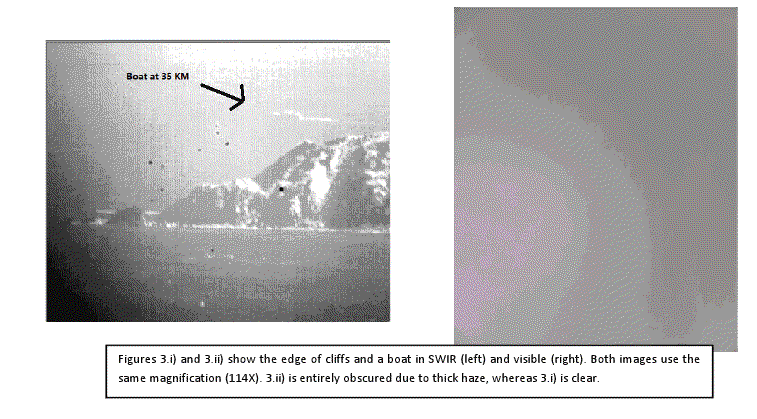
Another example of the tactical advantage of SWIR in long range, bad weather scenarios is shown in figures 4.i) and 4.ii).
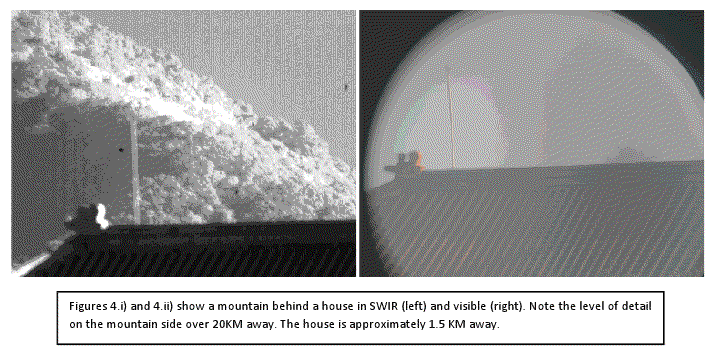
The quality of information from targets less than 20 KM away is also improved when SWIR technology is used. Figures 5.i), 5.ii) and 5.iii) show how fine details on a minaret less than 5 KM away can be exposed with just a 0.4 megapixel SWIR camera versus a 5.0 megapixel CCD visible light camera.
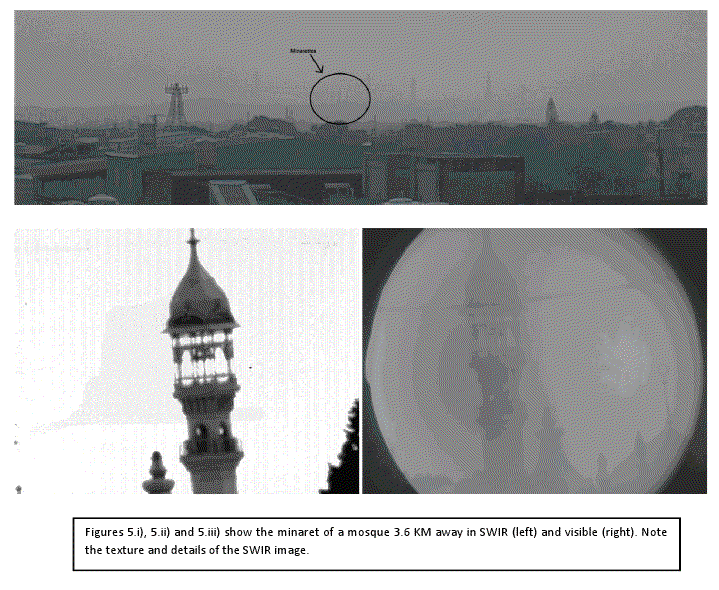
These pictures were taken using a modified 6” aperture telescope optimized for SWIR applications.
SWIR for Large Area Naval Surveillance
Water is a good absorber of SWIR light. This means water appears black when using a SWIR camera. An immediate use for this physical property is detecting maritime or other sea-borne objects. Figures 6.i) and 6.ii) demonstrate how many boats can be spotted and tracked quickly and easily over very large areas.
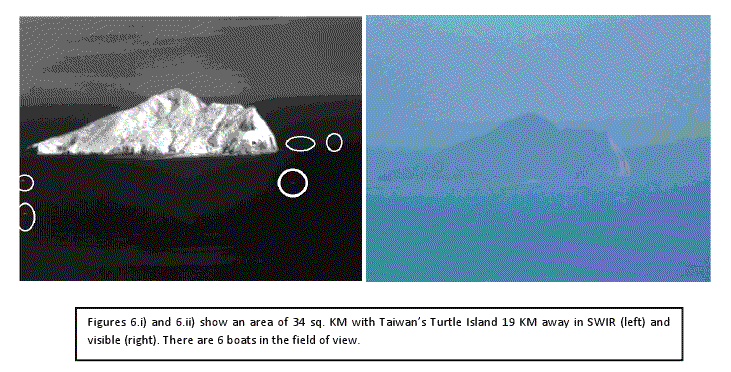
Large and small navy vessels painted to blend into the natural environment, as well as stealth boats with anti-RADAR surfaces can be detected over 20 KM away as large white spots on a black background with just simple SWIR optics. Shallow submersible objects will also be detectable. By measuring the position of a boat relative to the horizon, it is also possible to give a good estimate for range and therefore GPS position of that boat.
Helpful tips for choosing a SWIR camera system
When choosing a SWIR camera, some important considerations must be made taking into account your environment, application and budget. Is the application long range surveillance or large area surveillance? Will the camera be used mostly during the day or also at night? Will many cameras be used for a large area network or just one for a special scenario?
Legal Restrictions:
SWIR technology from the USA is considered highly sensitive and in most cases ITAR restricts export to any other country. If you are outside the USA, we would recommend making sure your camera is also produced outside the USA so as to avoid lengthy export license issues and other legal challenges. All ASP SWIR cameras are manufactured outside of the USA.
Resolution: ¼ VGA or full VGA
The resolution of a camera defines the level of detail obtained in an image. VGA resolution is equivalent to 1.3 megapixels. Most SWIR technology only comes in one of these two formats and the price and performance between them can differ substantially. It is also important to note, however, that the level of detail over a particular field of view can be altered much more cost-effectively by careful selection of optics. Figures 7.i) and 7.ii) are two images of the same landscape taken in both ¼ VGA and full VGA formats.
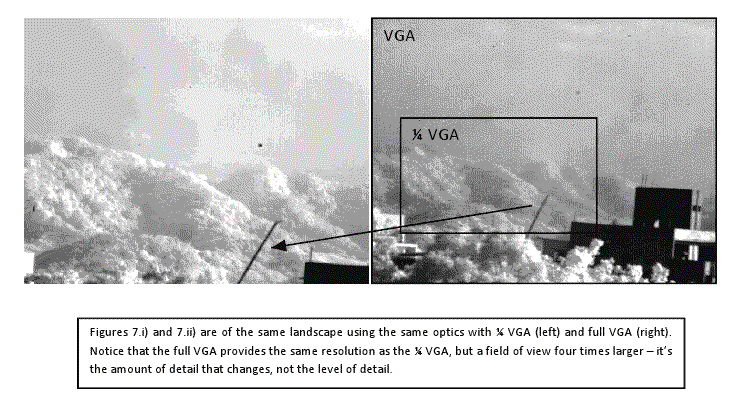
Wavelength of light versus pixel size in SWIR and LWIR cameras
For an experienced purchaser of thermal imaging cameras (LWIR), it is not uncommon to confuse the pixel size of a camera’s imaging chip with the wavelength of light the chip is to image. Typically, a LWIR camera images a wavelength of between 8 – 12 µm but has a pixel size of around 1 – 2 µm. A SWIR camera, on the other hand, images a wavelength of approximately 0.9 – 1.6 µm and has a pixel size of around 20 – 30 µm. For reference, the wavelength of visible light is often written as 0.4 – 0.7 µm.
Night Vision
Many sources of information on SWIR technology seem to provide conflicting opinions on use of these cameras for low light and night vision. Below (figure 8) is a typical image from an un-cooled SWIR camera at night over a nearby streetscape:
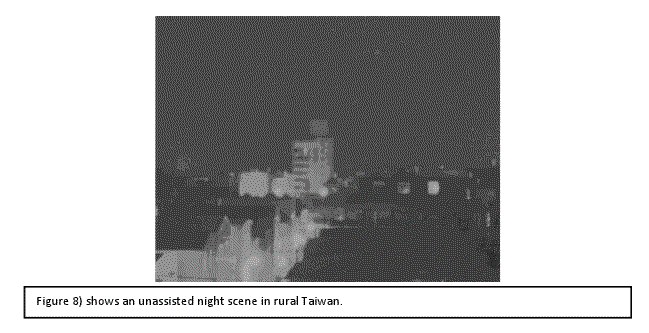
Figues 9.i) and 9.ii) are of a large tower mounted on a hill through fog at night with no moon.
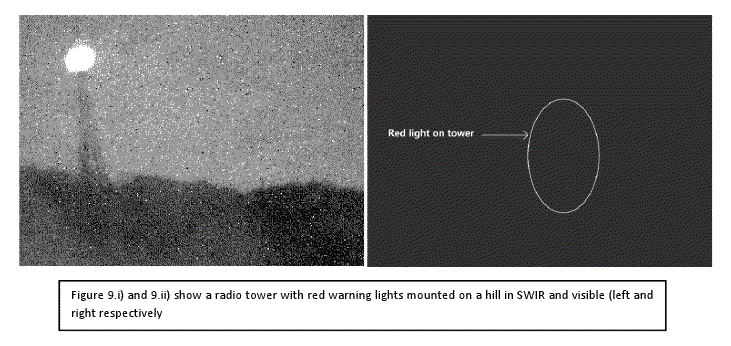
There are three main ways of improving the signal to noise ratio for night use:
1) Use a thermo-electrically cooled SWIR camera instead of an air-cooled version
Each brand of sensor has its own ability to handle low light levels and care must be taken to ensure you choose the right one. The level of cooling selected must also be taken into account: the greater the level of cooling, the better the signal to noise ratio (i.e. image quality). Today, almost all SWIR camera manufacturers produce air-cooled or electronically cooled versions meaning they can be placed in remote locations without need for maintenance.
2) Collect more light: increase exposure or use a larger aperture lens
This is a simple method for increasing the image quality output by any camera, SWIR or otherwise – the more light you have, the better your SNR. For example, figures 10.i) and 10.ii) show the same outdoor night scene with different integration times. The following images are taken using a Photonic Science Ltd. VGA SWIR Camera.
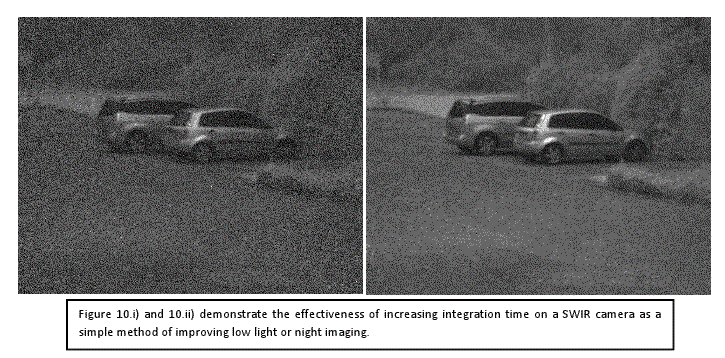
Another important point here is viewing a larger area (50 m distance) will give you much better signal than if you are viewing a small area (5 m distance).
3) Use an accessory e.g. laser illuminator
Using a lighting accessory is by far the most effective way of making your SWIR system operate at night. There is a wide selection of light sources available which are invisible to the human eye and standard night vision technology, but are bright white to SWIR (as shown in figures 11.i through 11.iv). The bottom two images were taken using a Photonic Science Ltd. VGA SWIR Camera.
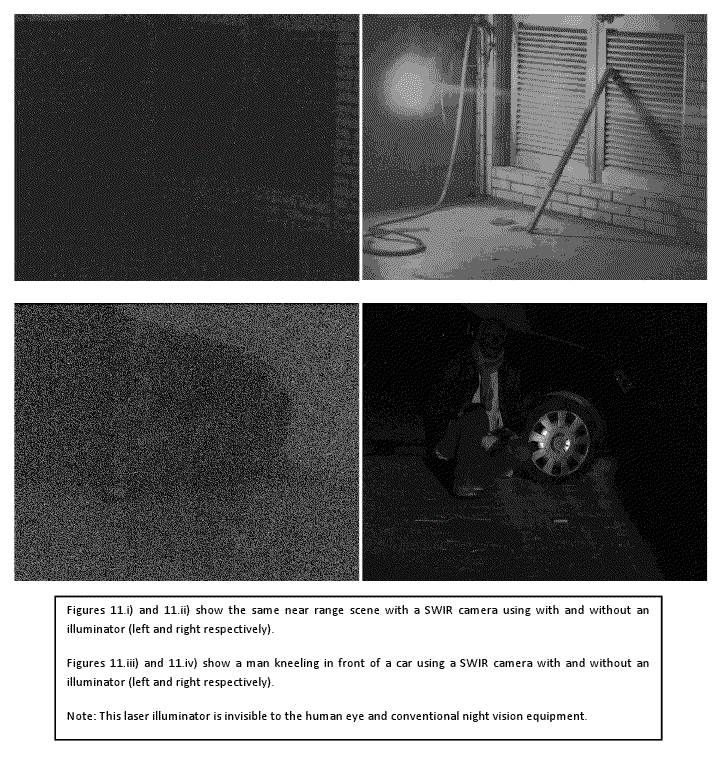
Allied Scientific Pro distributes cameras, telescopes and lenses for SWIR, LWIR and Visible camera solutions.